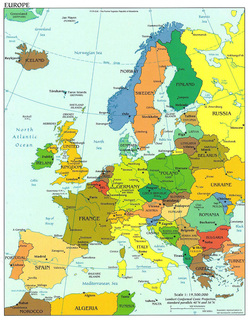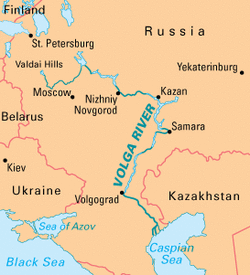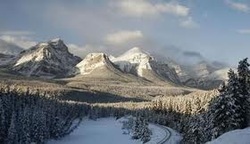Moving along, our next region to explore is Europe.
The region of Europe has 39 countries. These countries are categorized by North, Sourth, West and Central Europe. The countries that make up Europe are:
Northern Europe: Iceland, Denmark, Greenland, Sweden, Norway, Finland, Estonia, Latvia, Lithuania
Southern Europe: Portugal, Spain, Italy, Greece, Malta, Cyprus
Western Europe: United Kingdom, Republic of Ireland, France, Belgium, Luxembourg, Netherlands, Germany, Switzerland, Austria
Central Europe: Poland, Czech Republic, Slovakia, Hungary, Albania, Romania, Bulgaria, Slovenia, Croatia, Bosnia, Serbia, Montenergo, Macedonia.
Northern Europe: Iceland, Denmark, Greenland, Sweden, Norway, Finland, Estonia, Latvia, Lithuania
Southern Europe: Portugal, Spain, Italy, Greece, Malta, Cyprus
Western Europe: United Kingdom, Republic of Ireland, France, Belgium, Luxembourg, Netherlands, Germany, Switzerland, Austria
Central Europe: Poland, Czech Republic, Slovakia, Hungary, Albania, Romania, Bulgaria, Slovenia, Croatia, Bosnia, Serbia, Montenergo, Macedonia.
The first feature we will look at is Lake Balaton Hungary.
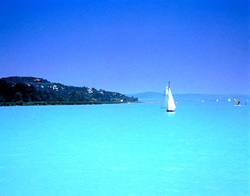
Lake Balaton Hungary is located in Transdanubia, Hungary. It is the largest fresh water lake in Central Europe. Lake Balaton Hungary was formed by tectonic forces 12,000-20,000 years ago. The lake itself is approximately 50 miles long. One of the characteristics of this lake is that in the North the lake is deep and shallow in the South. This makes the Southern end of the lake the tourist and resort spot. Families like swimming in the southern end because the temperatures of the water are that of bath water temperature. In the summer they have swimming and sailing races.
The next feature we are going to explore is the Volga River.
The Volga River arises in the Valdai Hills and flows Southwest to the Caspian Sea.
It is around 2,300 miles long and is used for power, transportation, irrigation and flood control. Several dams have been built along this river to use for hydroelectric power. Most of the freight transportation is done along this river. It was nicknamed the “Mother Volga.”
After our float down the river lets look at the Scandinavian Penninsula.

The Scandinavian Penninsula includes the countries of Norway and Sweden and is around 1,150 miles long. One fourth of the penninsula is north of the Artic Circle and makes up most of the Baltic Shield. 10,000 years ago it was covered by ice and the weight from the ice made the shield sink. After the ice melted the North started to rise again but the South continues to sink each year.
Next we are going to venture to the Balkan Range Mountains.
The Balkan Range Mountains run in a Southeast direction between Bulgaria and Serbia to the Black Sea. These mountains are not mountains that you would find a holiday skiier because they are far too dangerous for skiing.
The Highest peak of the Balkan Range Mountains is located in Central Balkan National Park and is named Botev. At 2,376 m. it has an endless dense forest with high cragged rocks, rolling hills and many waterfalls. Here you will find bear, wolves, deer and boar.
The last feature we will look at is Mount Etna.
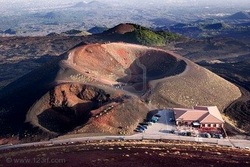
Mount Etna is the largest active volcanoe in Europe and is located in Sicily, Italy. The highest summit of Mount Etna is 3,350 m. and has the most document eruptions in the world. The volcanoe has a different variety of eruption styles and consists of a number of nested volcanoes that erupt simultaneously.
Now that we have looked at the features of Europe lets talk about the climate.
There are 3 different climate ranges in Europe due to all the bodies of water that surround it. These bodies of water create warm from the air currents from the Gulf of Mexico and damp weather that is really cold in the winter. These different climates are:
Temperate Midlatitude- moderate temperatures and rain. most common climate in Northwestern Europe. Here they grow potatoes, beets, turnips, and cabbage
Mediterranean- warm, dry summers with rainy winters
Humid Continental- hot summer and cold long winters with short growing seasons.
There are 3 different climate ranges in Europe due to all the bodies of water that surround it. These bodies of water create warm from the air currents from the Gulf of Mexico and damp weather that is really cold in the winter. These different climates are:
Temperate Midlatitude- moderate temperatures and rain. most common climate in Northwestern Europe. Here they grow potatoes, beets, turnips, and cabbage
Mediterranean- warm, dry summers with rainy winters
Humid Continental- hot summer and cold long winters with short growing seasons.
Next let's take a look at the different roles of the genders and how they have changed in the recent years.
Women have changed their role from the past as homemakers. Their main role of the family was homemaker and doing the majority of household duties and helping with the farming. Women were marrying early and having children at a young age. Now they are marrying later in life, having fewer children and working outside of the home. Women who work outside the home are also responsible for the household duties also called “double day.” (Pulsipher 2008). Politics is another place you will see women more now, whereas in the past they didn't even get to voice their political opinion. Spain is the country wth the most women in Eurpoe running for political seats.
Men, on the other hand, have a greater social status then the women do. They also have higher paying jobs with bigger titles. Even though a woman can work as the same position at the same job as a woman, the man will make more money. The men also have more freedom to move about then women do. The fact that women can run for a politcal position does not change the fact that the men have a higher public opinion then the women do.
Men, on the other hand, have a greater social status then the women do. They also have higher paying jobs with bigger titles. Even though a woman can work as the same position at the same job as a woman, the man will make more money. The men also have more freedom to move about then women do. The fact that women can run for a politcal position does not change the fact that the men have a higher public opinion then the women do.
Now we will talk about the different religions, population, transportation, resources and enviromental issues that are found in Europe.
The religion practice in Europe is Roman Catholic, Lutheran, Anglican and some Calvnist. Of these religions Roman Catholic is the religion that you will see practiced the most. It is being told that all the religions are decling by 10% except Islam. There is an increase in separation now between the church and the government. Some are pointing the finger at the low birth rates and more women using birth control which is against the Roman Catholic beliefs.
The Population of Europe is estimated around 728 million people which makes up about 11% of the entire world population. These numbers are now starting to decrease. With the decline in birth rates it is decreasing the number of daycares and the total hours of school that children are attending in a day. If women have fewer children they can work a full time job verses a part time job which happens to those with many children. If the women have 1 to 2 children and work a full time job with their spouse then that means the family will have more money to spend. With this decline in birth rates, economic growth it will be hard to maintain.
Most of the resources in Europe come from the mines. Germany's mines are Iron ore, coal and natural gas. United Kingdom has the majority of gypsum and chalk. Other areas spread out in Europe mine for uranium, lead, zinc, gold, limestone and salts. These mines and the factories provide most of the employment for the countries. The farms in Europe which are an average of 45 acres, which are smaller than the ones here in North America also are producing a majority of the food resources for Europe. The farm lands and forests cover most of Europe's land.
My country of focus is Italy. Everyone knows that Italy is famous for it's pizza, inexpensive railway system and exquisite art. Italy has beautiful vineyards and friendly people with the utmost hospitality. When I think of Italy I think of "Love." I would love to go to Italy and see the Coliseum n Rome, sip on an Expresso and sink my teeth into a hot slice of Italian pizza.
Transportation in Europe consists of Tram system, trains, buses, airplanes and cars. The Tram System is used the most it provides cheap transportation and is fast for the working class. Cars are used more so for families with children. They provide more comfort and flexibility for stopping and site seeing. If you are just backpacking and exploring then buses are the route to choose.
If we take a look at some of environmental issues happening in Europe today we will see that Germany is battling issues with acid rain. The acid rain has destroyed over half of the Black Forest by damaging the soil and killing the trees. Then there is the problem of nuclear activities that affect the ecosystem. With mining being a big resource of Europe it also creates enviromental issues from the all the pollutants that they create.
Last but not least let's look into the different cuisines here in Europe.
Because of the variety of cultures in Europe, it makes up a huge array of foods that are eatten. Organic foods are the preferred choice of all foods that are purchased in the markets. Pastries and Danishes are one of the huge varieties to choose from. Many of the meals prepared are family style meals. The British prefer their roasts, pork, poultry etc. The Greek are famous for the “Gyro”. The Irish, well we all know corn beef and cabbage with green beer. Because of the rolling hills vineyards are popular along water producing the majority of wines produced today. In Poland the popular Polish dish is Pierogies (which is made in my family).
References:
123RF Stock Photos: Royalty Free Stock Photos. 123RF limited 2006-2010. Retrieved from http://www.123rf.com
BgHike (2009). Hiking in Bulgaria: Bulgarian Mountain. Retrieved from http://www.bghike.com
The European Posse Ride (no copyright). Lake Balaton. Retrieved by http://www.europeanposseride.com
EuropeWorld.com (2008). Europe: Explore Europe Like Never Before! Retrieved from http://www.europeword.com
Foods of Europe (no copyright). Blogspot. Retrieved from http://www.kerriwarner.blogspot.com
How stuff works (1998-2011). The Volga River. Retrieved by http://www.geography.howstuffworks.com
USA Today (2008). World: Religion Takes A Backseat in Western Europe. Retrieved from http://www.usatoday.com
Volcano Live (no copyright). Mt Etna Volcano-John Search. Retrieved from http://www.volcanolive.com
Volga River (2011). In Encyclopedia Britannica. Retrieved from http://www.briannica.com
World Atlas Explore Your World (no copyright). Europe. Retrieved from http://www.worldatlas.com
World Lake Database (no copyright). Retrieved from http://www.ilec.or.jp
Transportation in Europe consists of Tram system, trains, buses, airplanes and cars. The Tram System is used the most it provides cheap transportation and is fast for the working class. Cars are used more so for families with children. They provide more comfort and flexibility for stopping and site seeing. If you are just backpacking and exploring then buses are the route to choose.
If we take a look at some of environmental issues happening in Europe today we will see that Germany is battling issues with acid rain. The acid rain has destroyed over half of the Black Forest by damaging the soil and killing the trees. Then there is the problem of nuclear activities that affect the ecosystem. With mining being a big resource of Europe it also creates enviromental issues from the all the pollutants that they create.
Last but not least let's look into the different cuisines here in Europe.
Because of the variety of cultures in Europe, it makes up a huge array of foods that are eatten. Organic foods are the preferred choice of all foods that are purchased in the markets. Pastries and Danishes are one of the huge varieties to choose from. Many of the meals prepared are family style meals. The British prefer their roasts, pork, poultry etc. The Greek are famous for the “Gyro”. The Irish, well we all know corn beef and cabbage with green beer. Because of the rolling hills vineyards are popular along water producing the majority of wines produced today. In Poland the popular Polish dish is Pierogies (which is made in my family).
References:
123RF Stock Photos: Royalty Free Stock Photos. 123RF limited 2006-2010. Retrieved from http://www.123rf.com
BgHike (2009). Hiking in Bulgaria: Bulgarian Mountain. Retrieved from http://www.bghike.com
The European Posse Ride (no copyright). Lake Balaton. Retrieved by http://www.europeanposseride.com
EuropeWorld.com (2008). Europe: Explore Europe Like Never Before! Retrieved from http://www.europeword.com
Foods of Europe (no copyright). Blogspot. Retrieved from http://www.kerriwarner.blogspot.com
How stuff works (1998-2011). The Volga River. Retrieved by http://www.geography.howstuffworks.com
USA Today (2008). World: Religion Takes A Backseat in Western Europe. Retrieved from http://www.usatoday.com
Volcano Live (no copyright). Mt Etna Volcano-John Search. Retrieved from http://www.volcanolive.com
Volga River (2011). In Encyclopedia Britannica. Retrieved from http://www.briannica.com
World Atlas Explore Your World (no copyright). Europe. Retrieved from http://www.worldatlas.com
World Lake Database (no copyright). Retrieved from http://www.ilec.or.jp
